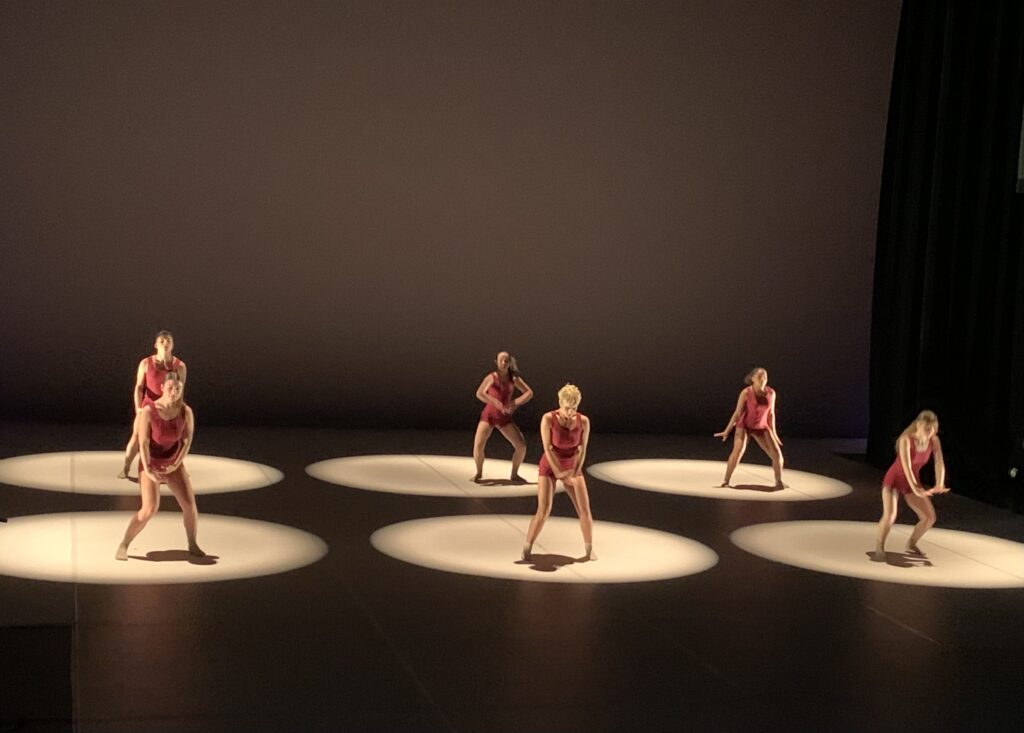
Clockwise from left: Sebastian Goodman, Lila Sauer, Jazalynn Thompson, Sophie Bartlett, Fallon Brackley, and Jules Rizzo. Not pictured: Sophie Tiede.
MADDIE LUEBKERT / Staff Writer —-
Sharon Martin Hall, audience buzzing with anticipation, light glinting off timpanis, cymbals, xylophone, and drums, Denison Dance Department’s event, “Renaissance/Renacimiento/复兴,” was about to start.
As the lights dimmed, dance department faculty members Ojeya Cruz Banks and Marion Ramíres stepped into the spotlight to introduce the show. They explained that this performance was a celebration of life as well as a reflection on the power and beauty of nature while also pointing out the interdisciplinarity of dance, music, and technology, as the dancing would be performed with live music and film playing in the background.
Banks and Ramíres mentioned that this performance was one of the first to showcase the newly developed Denison Dance Company with guest choreography from OSU Dance Department, Eddie Taketa and Joshua Manculich, as well as Columbus’s Whirlwind Dance Company. Recent graduate Sebastian Goodman ‘23 had returned to help as the rehearsal director and performer in the show.
Banks added that the faculty running the show “[were] so proud of the students” performing, and that “it has been amazing to watch [the students] evolve as dancers.” Before stepping away and starting the show, Ramírez remarked how she wanted the audience to sit and get comfortable as she directed the audience to feel their feet rest on the floor and feel the support from the chair underneath them. She told the audience to close their eyes and focus on their breathing, the sense of the cool air as the audience breathed in and the warmth of the air as they breathed out. As the audience opened their eyes, Banks and Ramíres stepped away as the show began.
As the lights dimmed, a spotlight shined on the composer in the corner as he lightly tapped the cymbals. Light bursted out from the left side of the stage, and a dancer with a large blue scarf emerged. This first dance was titled “Påkyo/Tormenta/Typhoon.” According to the program, the dance represented the destruction and aftermath that a typhoon can bring to a landscape. Behind the dancers on the stage, images flashed on the wall, ranging from palm trees standing stationary to wildly swaying in the typhoon’s winds.
After the first performance, the dancers left the stage. The background film changes from palm trees and stormy weather to a dark sky illuminated by stars. Maya Blackmon ‘26 stepped out from the stage with a guitar in their hand, performing the song, “We Watch The Stars” by singer-songwriter Fink.
After Blackmon exited, eight dancers stepped onto the floor dressed in maroon. Each dancer resided in circles shining on the floor. The program notes that this piece titled “The Rate In Which I Am” was commissioned by DanceWorks Chicago, Museum of Contemporary Art. This piece was about stillness and the importance of taking a step back and reflecting.
The final piece of the performance was titled “Kipuka II.” Kipuka is a type of land that one or more flows of lava surround. On the wall behind the stage, a video started playing of just a small amount of lava flowing on the top left corner of the wall, and as the dance went on, the lava flowed until it covered the entire wall. The dancers in all-white costumes started dancing to an intense and electronic beat as lava continued to flow behind them. After the final moments of choreography by Taketa, the dancers lined up in the middle of the stage and took their bows. The show finished on a light-hearted note, as dancers broke away from the line dancing as Dua Lipa’s “Dance The Night Away” began to play, signaling the show’s end.
